Abstract
The questionable efficacy of Live High Train High altitude training (LHTH) is compounded by minimal training quantification in many studies. We sought to quantify the training load (TL) periodization in a cohort of elite runners completing LHTH immediately prior to competition. Eight elite runners (6 males, 2 females) with a V̇O2peak of 70 ± 4 mL·kg-1·min-1 were monitored during 4 weeks of sea-level training, then 3-4 weeks LHTH in preparation for sea-level races following descent to sea-level. TL was calculated using the session rating of perceived exertion (sRPE) method, whereby duration of each training session was multiplied by its sRPE, then summated to give weekly TL. Performance was assessed in competition at sea-level before, and within 8 days of completing LHTH, with runners competing in 800 m (n = 1, 1500 m/mile (n = 6) and half-marathon (n = 1). Haemoglobin mass (Hbmass) via CO rebreathing and running economy (RE) were assessed pre and post LHTH. Weekly TL during the first 2 weeks at altitude increased by 75% from preceding sea-level training (p = 0.0004, d = 1.65). During the final week at altitude, TL was reduced by 43% compared to the previous weeks (p = 0.002; d = 1.85). The ratio of weekly TL to weekly training volume increased by 17% at altitude (p = 0.009; d = 0.91) compared to prior sea-level training. Hbmass increased by 5% from pre- to post-LHTH (p = 0.006, d = 0.20). Seven athletes achieved lifetime personal best performances within 8 days post-altitude (overall improvement 1.1 ± 0.7%, p = 0.2, d = 0.05). Specific periodization of training, including large increases in training load upon arrival to altitude (due to increased training volume and greater stress of training in hypoxia) and tapering, were observed during LHTH in elite runners prior to personal best performances. Periodization should be individualized and align with timing of competition post-altitude.
Key points.
Athletes experienced in altitude training did not complete 1-2 weeks of low intensity training during the initial acclimatization to altitude, as generally recommended, but instead commenced high intensity training after 2-4 days
Whilst training load was acutely increased at altitude through a combination of increased volume and training under hypoxia, athletes did not exceed training volumes to which they were previously accustomed
Prior to competition, athletes completed a taper in the final week of LHTH, which was individualized based on the volume of prior training, preferred event, and timing post altitude
Key words: Altitude training, performance, hypoxia, tapering
Introduction
Live High Train High (LHTH) refers to athletes living and training at natural altitude for a period of time (usually 2-4 weeks) to prepare for competitions at altitude, or to improve sea-level performance (Saunders et al., 2009). The potential benefit of LHTH over other forms of altitude training such as Live High Train Low (LHTL) is the provision of an additional hypoxic training stress which may increase the relative intensity of training (Pugliese et al., 2014), in addition to the acclimatization benefits of altitude residence, including accelerated erythropoiesis (Friedmann-Bette, 2008).
The general consensus from coaches and athletes is that LHTH improves physiological capacities and performance in competition during endurance events, a notion evidenced by its frequent and continued use by elite athletes (Pugliese et al., 2014; Solli et al., 2017) and supported by several studies in the literature (Daniels and Oldridge, 1970; Gore et al., 1998; Bonne et al., 2014). Accordingly, a meta-analysis reported a 1.6 ± 2.7% improvement in performance for elite athletes following LHTH (Bonetti and Hopkins, 2009). However, the large variability in these results (exemplified by a standard deviation approaching twice the mean effect) is confirmed by studies reporting no change or a decrement in performance following LHTH (Adams et al., 1975; Jensen et al., 1993; Levine and Stray-Gundersen, 1997; Bailey et al., 1998; Gough et al., 2012). Factors which might explain these equivocal findings include the altitude at which athletes lived and trained (Bailey et al., 1998), relative intensity of training sessions (Lundby et al., 2012), athlete iron status or supplementation protocol (Stray-Gundersen et al., 1992), and a reduction in training quality mediated by lower oxygen availability (Chapman et al., 1998).
To analyze and establish causal relationships between the training performed and the resultant physiological and performance adaptations, it is imperative to precisely and reliably quantify training load (TL) (Mujika, 2013). A limitation of many LHTH studies is that only basic metrics such as overall training volume or duration have been reported (Adams et al., 1975; Gore et al., 1997; Bailey et al., 1998). Without appropriate quantification, it is no surprise that both the literature and anecdotal evidence from coaches is conflicting regarding the best training strategies to employ during altitude camps, and the optimal time to compete thereafter (Chapman et al., 2014). Longitudinal TL data from LHTH training sojourns, combined with related athlete performance data may assist coaches and scientists to identify training periodization strategies that may be employed by elite athletes during LHTH to improve sea-level performance.
As such, in a cohort of elite runners, we sought to firstly; quantify the training load (TL) periodization during LHTH, and secondly; describe the physiological and performance changes following LHTH at 2100 m.
Methods
Participants
Eight athletes (6 males, 2 females; age, 25 ± 6 years; V̇O2peak, 70 ± 4 mL·kg-1·min-1; Season’s Best as % of World Lead, 90% ± 5%;) participated in 3-4 weeks of LHTH in Flagstaff, USA (elevation 2100 m) after 4 weeks of quantified near sea-level training (three weeks LHTH, n = 3; four weeks LHTH, n = 5). Of these athletes, 5 represented Australia internationally at the 2016 Olympic/Paralympic Games and/or 2015 IAAF World Championships. Three athletes (participants 4, 7 and 8) had previously trained in Flagstaff and four of the remaining athletes (participants 1, 2, 3 and 6) had experienced LHTH at 1600 to 1800 m in Australia. All of these athletes had participated in at least 1 LHTH camp in Australia within the 4 months preceding the investigation. Additionally, 4 of these athletes (participants 2, 4, 7 and 8) had an extensive history of altitude training utilizing both natural LHTH and simulated LHTL over the preceding 3 to 5 years (2-3 camps annually). One athlete (participant 5) had never engaged in altitude training previously. All procedures and risks were explained to participants before they provided written informed consent to participate. Ethical approval for the investigation was granted by the institutional ethics committees (University of Canberra – HREC ref. no. 15-45 and Australian Institute of Sport – approval no. 20150613) and all procedures complied with the Declaration of Helsinki.
Study design
The investigation was an observational cohort case study examining the training of elite middle-distance runners during an in-season training intervention. Participants’ training sessions were individually tailored and designed by their coaches, and were not manipulated or directly influenced by researchers involved in the study.
The investigation took place immediately following the Australian domestic track season, and before the American/European summer season, in April-June. The training of each athlete was monitored for 7-8 weeks in total, and was divided into 2 phases. The first phase involved athletes completing 4 weeks of their own, coach-prescribed training at or close to sea-level (i.e. Lead-in phase). Six athletes completed the first 2-3 weeks of this phase in their home environment in Australia, then travelled overseas, in most cases for competition (n = 2 in Nassau, Bahamas, n = 2 in San Francisco, USA). During the final week of this lead-in phase, these 6 athletes convened in San Francisco, where they resided for the remaining 4-7 days of this period, thus acclimating to the same time-zone as Flagstaff and minimizing any effects of jet-lag (Fowler et al., 2017) occurring simultaneously to altitude adjustment. The remaining 2 athletes completed this entire phase in Australia. Immediately following, participants travelled to Flagstaff (2100 m elevation) to complete 3-4 weeks (hypoxic dose = 1109-1512 km.h-1; Garvican-Lewis et al., 2016) of LHTH (i.e. Altitude phase). All participants were supplemented with oral iron (Ferro-Grad C, Abbott Laboratories, Australia, 105 g elemental iron) daily for at least 1 week prior to and for the duration of LHTH to ensure erythropoietic adaptations were not compromised by insufficient iron availability (Stray-Gundersen et al., 1992). Athletes competed in competitive races within a week of completing LHTH. Laboratory testing of running economy and haemoglobin mass occurred at the commencement and conclusion of the altitude phase (within 24-48 hours of arrival and departure to/from Flagstaff).
Training
The structure of a typical training week for all athletes is shown in Table 1. Whilst generally adhering to this similar structure, training was individualized for each athlete based on previous altitude training experience (Table 2), preferred event (Table 3), physiological characteristics, and anecdotal results regarding the best training strategy for the current altitudes; therefore, not all athletes were on identical training programs. For example, race pace and some V̇O2max intensity sessions were modified to include additional recoveries between intervals in order to maintain running speed, whereas threshold and low-intensity training were not modified (i.e. same interval/recovery length), but performed at a reduced speed and/or higher perceived effort compared to sea-level (Sharma et al., 2017). All athletes completed a taper during the final week of the camp in preparation for upcoming races occurring immediately following LHTH, following either 2 or 3 weeks of full training depending on their total camp duration. Training was completed between 2100 to 2700 m with the exception of one race pace session (~ 90 min) completed at 1400 m (Sedona, USA) towards the end of the training camp.
Table 1.
General structure of a training week at sea-level and altitude.
| MON | TUES | WED | THURS | FRI | SAT | SUN | |
|---|---|---|---|---|---|---|---|
| AM | 6-10 km @ low intensity |
Intervals + hills @ V̇O2max intensity | 10-20 km @ low to moderate intensity |
Race pace | Strength training | Threshold | 16-30 km @ low to moderate intensity |
| PM | Strength training + 6-8 km @ low intensity |
30-40 min run/swim @ low intensity |
30-40 min run/swim @ low intensity | 6-8 km @ low intensity or rest |
Table 2.
Training structure of initial week at altitude depending on prior experience.
| Day 1 (arrive) | 2 | 3 | 4 | 5 | 6 | 7 | |
|---|---|---|---|---|---|---|---|
| New to altitude | Easy run | 2 easy runs | 2 runs or 1 medium length run |
Threshold to V̇O2 max |
Strength training | Race pace |
Long run |
| Previous altitude experience | Easy run | Easy run AM threshold run PM |
2 runs or 1 medium run |
V̇O2 max + race pace strides | Strength training | Race pace |
Long run |
Table 3.
Representative full training and taper weeks at altitude for distance and middle distance athletes
| Full training | Monday | Tuesday | Wednesday | Thursday | Friday | Saturday | Sunday |
|---|---|---|---|---|---|---|---|
| Distance | AM – 50 min PM – 30 min |
AM – 8 x 1 km/600 m @ HM* pace -5s/HM pace +20s PM – 30 min |
AM – 90 min + gym PM – 20 min + drills/strides |
AM – 8 x 400 m with 200 m float + 6 min threshold PM – 30 min |
AM - 60 min | AM – 10 min threshold + 6 x 200 m hills + 10 min threshold PM – 30 min |
145 min |
| Middle-distance | AM – 45 min PM – Gym + 30 min |
AM – 36 min fartlek PM – 35 min |
AM – 60 min PM – 25 min |
AM – 4 x 400 m, 4 x 300 m, 6x200 m PM – 35 min |
AM - Gym | AM – 3 km threshold, 6 x 300 m hills | 105 min |
| Taper | - 6 days | - 5 days | - 4 days | - 3 days | - 2 days | - 1 days | Race day |
| Distance | AM – 60 min + Gym |
AM – 3 km @ HM pace, 2 x 1 km @ 5 km/10 km pace PM – 30 min |
AM – 60 min | AM – 4 x 2 min @ HM pace, 2 x 1 min @ 5 km pace |
AM – 40 min PM – travel from altitude |
AM – 30 min | AM – ½ marathon race |
| Middle-distance | 80 min | AM – 35 min PM – Gym + 25 min |
AM – 2 x (1200 m, 3 x 300 m) |
AM – 45 min | Rest | AM – 5 km + strides PM – travel from altitude |
AM – 4 km PM – mile race |
* Half-marathon
Training monitoring
Each athlete recorded all their running training on a GPS watch (Forerunner, Garmin International, Kansas, USA), including total distance (kilometers) and duration (min). Duration was also recorded for cross training or strength training sessions. A session rating of perceived exertion (sRPE) score on a modified Borg scale was provided for all training sessions (Foster, 1998). Training volume (TV) was calculated as total running distance completed each week in kilometers. Daily TL was calculated as the duration of each training session multiplied by sRPE, then summated to give weekly TL. To assess the relationship between weekly TL and TV at sea-level and altitude, weekly TL was divided by weekly TV to give a load/volume ratio.
Performance
The research project was arranged around domestic and international track and field competitions, and the race times of athletes were collated as a record of performance. Running performance was recorded before and after LHTH. The season’s best time achieved during the track season preceding the investigation was used as the pre-altitude measure. For 7 of 8 athletes, post-altitude races were completed within 8 days of descending from altitude. These races took place in the USA (Boston, n = 3; Nashville, n = 2; San Diego, n = 1) and Europe (Oslo, n = 1). One participant began competing after 4 weeks at sea-level (Participant 8, who in consultation with his coach, elected to race following a period of sea-level training due to timing of season objectives and personal preference). All races were completed at or near to sea-level (19 to 182 m) on standard 400 m athletics tracks. Of the athletes, 1 competed in the half-marathon, 5 in the 1500 m, 1 in the mile (1609 m), and 1 in the 800 m. Athletes were free to employ their own preparations and use of legal ergogenic aids such as caffeine, but were asked to keep this consistent between races.
V̇O2peak
An incremental running test was completed at sea-level prior to departure to altitude on a custom built motorized treadmill (Australian Institute of Sport, Australia) to determine V̇O2peak. The test consisted of a self-selected warm-up followed by an incremental protocol commencing at a speed of 14-16 km.h-1, depending on the athlete, and increasing by 0.5 km.h-1 every 30 s until an increase of 4 km.h-1 from the starting speed. After 30 s at terminal speed, the gradient was increased from 0% every 30 s by 0.5% until volitional exhaustion. Heart rate was measured continuously via telemetry (Polar Electro, Kempele, Finland). Expired gases were collected throughout the test for determination of minute ventilation (V̇E), V̇O2, V̇CO2 and respiratory exchange ratio, using a metabolic cart (custom-built, open-circuit, indirect calorimetry system described previously [Saunders et al., 2004]). V̇O2peak was taken as the highest 30 s value.
Running economy
Submaximal running economy was measured on a motorized treadmill (Pro, Woodway, Germany). This testing was completed at altitude in Flagstaff and occurred at the commencement and conclusion of the altitude phase (within 24-48 hours of arrival and departure to/from Flagstaff). Participants completed the same self-selected warm-up before each test, followed by 4 min at 16 km·h-1. Heart rate and expired gases (True One 2400, ParvoMedics, USA) were collected throughout the test. Prior to each test, the ParvoMedics system was calibrated to room air and a gas of known concentration (16% O2 and 4% CO2). A 3-liter syringe was used to calibrate flow. Submaximal running economy and ventilation were respectively taken as mean V̇O2 and V̇E measured during the final minute at 16km·h-1.
Haemoglobin mass
Total Hbmass was measured at the same time-points as running economy (i.e. at altitude in Flagstaff) using the 2 min CO rebreathing method with some modifications (Schmidt and Prommer, 2005). Briefly, participants rebreathed a CO bolus equivalent to 1.3 ml·kg-1 of body mass for a period of 2 min. Capillary blood samples were drawn at the start of the test and 7 min post administration of the CO dose for determination of the percentage of bound carboxyhaemoglobin (%HbCO). Blood samples were measured a minimum of 5 times for %HbCO using an OSM3 hemoximeter (Radiometer, Copenhagen, Denmark). Expired CO was determined using a Draeger Pac 7000 (Lubeck, Germany) CO sensor. Hbmass was calculated from the mean change in %HbCO before and after rebreathing. Due to the nature of the investigation involving elite athletes on specific training schedules, Hbmass could only be assessed a single time both pre and post-intervention. The typical error of measurement for Hbmass of the investigator administering the tests (obtained from repeated measures within 48 hours on 6 participants taken within 6 weeks of departure to Flagstaff) was 1.1% (90% confidence limits = 0.7, 2.3%).
Statistical analysis
The magnitude of changes in weekly TL and TV were quantified using standardized mean difference (Cohen’s d effect sizes), whereby the change in parameter values were divided by the pooled standard deviation (SD). Changes for laboratory measures and performance were analyzed using paired t-tests, with effect sizes (Cohen’s d) and percentage changes also calculated along with 90% confidence limits (CL). Effects sizes were interpreted using effect thresholds of < 0.2, 0.2, 0.5, and 0.8 for trivial, small, moderate, and large effects respectively, and expressed with 90% CL to denote the imprecision of the estimate. Data are displayed as mean ± SD unless otherwise stated and alpha was set at p ≤ 0.05. Testing was performed using the SPSS statistical package (IBM, New York, USA).
Results
Training
Training load changes are shown in Figure 1A. There was a very large increase in weekly TL (Figure 1B) between the lead-in period and first 3 weeks (first 2 weeks for n = 3 athletes completing 3 weeks LHTH) at altitude (1193 ± 371 to 1903 ± 455, p = 0.0002, d = 1.71 [0.67, 2.56], % change [90% CL] = 77 [31, 123]). All athletes increased TL during LHTH relative to lead-in (Figure 1A, range 24 to 256%). TL during each of weeks 1 and 2 of LHTH were significantly greater (p < 0.01, d = 1.46-2.06) than each of weeks 2, 3 and 4 of the lead-in period.
Figure 1.
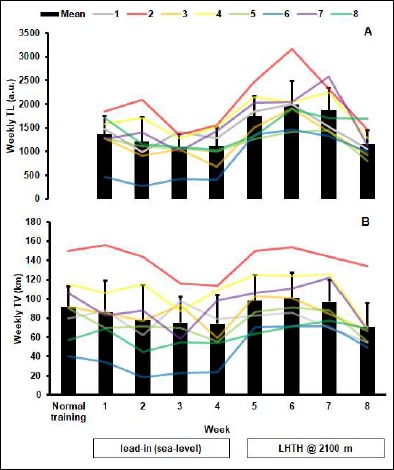
A) Quantification of weekly TL and B) weekly TV during lead-in and intervention periods. Histograms represent the mean response, and coloured lines the individuals indicated in the legend. Week 7 represents the 3rd week for athletes completing 4 weeks of LHTH (n = 5), with week 8 being the final week for all (n = 8). Normal training is the 4 weeks prior to the commencement of the study, TV was habitually recorded by participants during this period, however TL was not quantified.
In the 4 weeks prior to the lead-in period mean TV was 91 ± 22 km. During the lead-in period and first 3 weeks of LHTH (first 2 weeks for n = 3 athletes completing 3 weeks LHTH), athletes completed 78 ± 30 and 101 ± 26 km respectively. Weekly TV increased from lead-in to weeks 1 and 2 of the intervention period (p = 0.02, d = 0.83 [-0.07, 1.64], % change = 44 [8, 80]). When a participant was excluded (participant 6) due to illness during the lead-in period (187% increase in TV), the mean increase was 23% (16, 31%).
Athletes scheduled to compete within 8 days following LHTH (7 of 8) recorded a reduced TL (1166 ± 276) and TV (71 ± 25 km) during the final week of LHTH, which was significantly lower (43%, range 28 to 49%; p = 0.002; and 33%; range 12 to 44%; p = 0.002 respectively) than weekly TL and TV of the first 3 weeks of LHTH (first 2 weeks for n = 3 athletes completing 3 weeks LHTH). The load/volume ratio (Figure 2) increased significantly during LHTH compared to lead-in (15.8 ± 2.9 to 18.5 ± 2.7, p = 0.008, d = 0.96 [0.05, 1.77]), with 7 of 8 athletes recording a higher value during LHTH. Representative individual examples of daily and weekly periodization of TL and TV are shown in Figure 3 for distance (Figure 3A) and middle-distance (Figure 3B) athletes.
Figure 2.
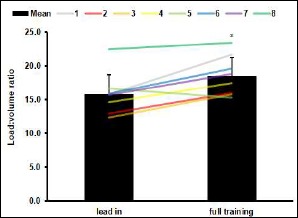
Changes in load/volume ratio from sea-level to altitude with individual responses. This value was calculated by divided weekly training load by training volume. Lead in refers to the initial 4 weeks of sea-level training. Full training is the first 3 weeks of the altitude period (first 2 weeks for n = 3 completing 3 weeks of LHTH). Histograms represent the group mean, coloured lines are individuals indicated in the legend. * significantly different to lead in, p < 0.05.
Figure 3.
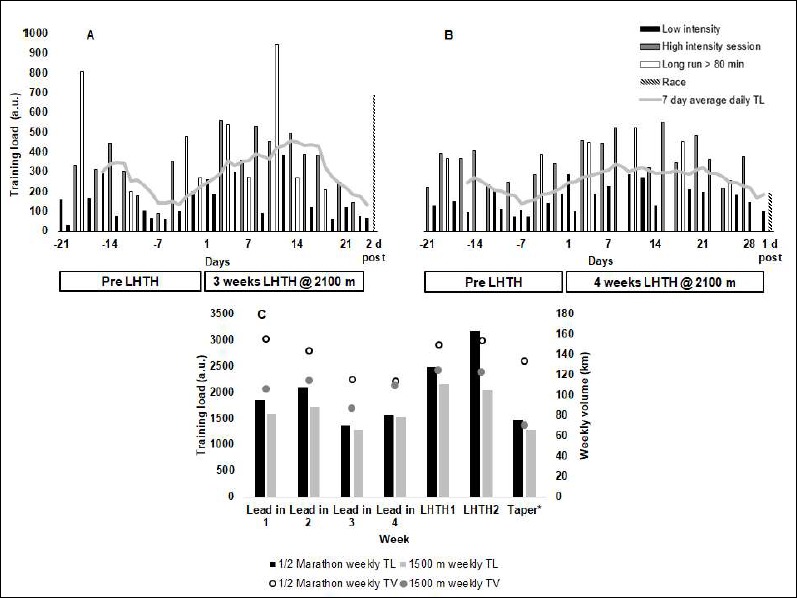
Representative individual examples of daily periodization of running TL for A) distance (10000 m/half-marathon – participant 2) and B) middle-distance (800/1500 m – participant 4) athletes. C) Representative examples of Weekly TL and TV for distance and middle-distance athletes. * Taper is the final week of the intervention period for both athletes - week 3 for the distance athlete and week 4 for middle-distance; the latter completed 126 km and 2242 a.u. TL during their week 3.
Performance
Of the 8 athletes, 7 competed in races with the first 8 days following LHTH, and all 7 achieved lifetime personal bests, an average of 3.7 days post-altitude (range 1 to 8 days; Table 4). Participant 8 began competing ~ 4 weeks following LHTH and achieved a lifetime personal best on day 57 post-altitude. The overall improvement of athletes compared to their prior season’s best time was 1.1 ± 0.7% (p = 0.2, d = 0.05).
Table 4.
Individual performance changes following LHTH.
| Athlete | Age | Sex | Performance level | Event | Performance time – pre (mm:ss.00) |
Performance time – post (mm:ss.00) |
% change | Days post LHTH |
|---|---|---|---|---|---|---|---|---|
| 1 | 23 | M | Provincial | 1500 m | 04:13.26 | 04:13.22 | - 0.0 | 1 |
| 2 | 27 | F | Top 10 IAAF World Championships, Olympian |
Half- marathon |
71:51.00 | 71:07.00 | - 1.0 | 2 |
| 3 | 25 | F | IAAF World Indoor Championships finalist |
1500 m | 04:09.41 | 04:05.56 | - 1.5 | 6 |
| 4 | 38 | M | National finalist | Mile | 04:06.20 | 04:01.81 | - 1.8 | 1 |
| 5 | 19 | M | IPC World Championship and Paralympic medalist, WR holder | 1500 m | 04:06.60 | 04:05.39 | - 0.5 | 1 |
| 6 | 18 | M | National junior medalist | 1500 m | 03:50.50 | 03:46.33 | - 1.8 | 7 |
| 7 | 27 | M | IPC World Championship and Paralympic medalist, WR holder | 1500 m | 03:50.61 | 03:48.55 | - 0.9 | 8 |
| 8 | 23 | M | IAAF World Championships representative | 800 m | 01:47.52 | 01:45.79 | - 1.6 | 57 |
| Mean (SD) | 25.0 (6.2) | - 1.1(0.7) |
IAAF = International Association of Athletics Federations, IPC = International Paralympic Committee, WR = World Record, LHTH = Live High Train High
Laboratory measures
Laboratory measures were conducted on 7 of 8 participants, with 1 participant (participant 6) being excluded from post-testing due to illness. Total Hbmass increased significantly following LHTH (785 ± 203 to 826 ± 210 g, p = 0.006, d = 0.20 [-0.71, 1.07], % change = 5.3 [3.3, 7.4]; Figure 4A). Relative Hbmass also increased significantly following LHTH (12.5 ± 1.9 to 13.2 ± 1.9 g·kg-1, p = 0.006, d = 0.37 [-0.54, 1.23], % change = 5.2 [2.5, 8.0]). All athletes achieved increases in Hbmass (range 1.2 to 9.7 %); athletes completed 3 weeks of LHTH had a mean change of 4.9 ± 1.0%, with those completing 4 weeks increasing Hbmass by 5.6 ± 3.6%. Tested athletes who were < 24 years of age (n = 3) increased Hbmass by 8.0 ± 1.7%, with athletes > 26 years (n = 3) increasing Hbmass by 2.6 ± 1.0%.
Figure 4.
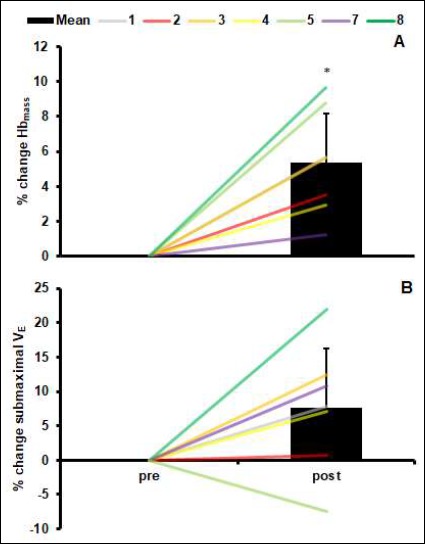
Percentage change in Hbmass (A) and submaximal V̇E (B) following 3-4 weeks of LHTH for n = 7 (Participant 6 excluded due to illness during post testing). Coloured lines are individuals indicated in the legend, with histograms showing the group response. * p < 0.01.
Changes for submaximal ventilation (V̇E) are shown in Figure 4B. RE at 16 km.h-1 remained unchanged following the intervention period (pre: 3.5 ± 0.5 L.min-1, post: 3.4 ± 0.5; p = 0.12, d = 0.17 respectively). V̇E at 16 km·h-1 tended towards increasing after LHTH (p = 0.11, d = 0.30 [-0.58, 1.19], % change = 7.6 [1.5, 13.8]).
Discussion
The main findings of this case study were as follows:
Compared to sea-level lead-in training, TL and TV were increased by 77% and 44%, respectively, during LHTH.
The increase in TL occurred immediately upon arrival to altitude, with athletes foregoing the traditional acclimatization period of low intensity training.
Compared to peak weekly values at altitude, there was a large reduction in TL (43%) and TV (30%) in the final week of LHTH for athletes competing within 8 days following LHTH.
All 7 athletes competing within 8 days of completing LHTH achieved personal record performances.
It must be noted our observational case study design of athletes completing individualized training does not allow us to isolate the relative contributions of intensified training and altitude exposure in improving performance. However, these data provide important information regarding training periodization strategies which may be employed by elite runners engaging in LHTH prior to competition, and are therefore of interest to coaches and scientists prescribing altitude training.
Performance
A combination of intensified training, tapering and 3-4 weeks of LHTH at 2100 m was observed immediately prior to athletes achieving a 1.1% improvement in competitive race performance (Table 4). This degree of improvement is in accordance with previous uncontrolled (Daniels and Oldridge, 1970; Gore et al., 1998) and controlled (Bonne et al., 2014; Rodriguez et al., 2015) investigations examining the effect of LHTH on performance involving elite populations, with improvements ranging from ~ 1 to 4% reported.
The question of the optimal time to compete following altitude training has received considerable attention, with the focus being on the decay of physiological adaptations conferred by altitude training (Chapman et al., 2014), including the increase in Hbmass and ventilatory acclimatization, as well as changes in neuromuscular factors (e.g. changes in stride mechanics, ground contact time, muscle recruitment). A ~ 5% increase in Hbmass was observed following LHTH in the current study (Figure 4A), an expected finding in accordance with previous studies (Gore et al., 2013; Rodriguez et al., 2015) and the hypoxic dose experienced by the athletes (Garvican-Lewis et al., 2016). However, the range of observed increases (1 to 9%) was quite large. It has been previously noted that certain individuals, based on genetic predisposition, may well have a beneficial response to lower “doses” of altitude, whilst others may require longer exposure to altitude to induce adaptations (Levine and Stray-Gundersen, 2006). Additionally, age may have played a role, with older athletes (> 26 years) increasing Hbmass by only ~ 3% compared to their younger counterparts (8% increase). Whilst experienced, elite athletes are frequently observed to increase Hbmass following altitude training (Millet et al., 2017), the lower relative training age and potentially greater room for adaptation in the younger athletes may have contributed to their superior response.
Given the largely aerobic nature of middle distance events (Gastin, 2001), the increase in Hbmass would theoretically be advantageous to performance. However, if altitude induced increases in Hbmass are quickly negated upon return to sea-level, this could affect the optimal timing of competition. In elite Kenyan runners, Hbmass remained stable for the first 14 days at sea-level but declined by 6% after five weeks (Prommer et al., 2010). Therefore, acquired Hbmass was likely still at or close to its peak during the 8 day post-altitude window during which the majority of participants competed in the current study. Alternatively, training with additional Hbmass is also beneficial, and may explain increased performance several weeks following altitude training, regardless of whether Hbmass has returned to baseline levels (Chapman et al., 2014). Accordingly, participant 8 commenced competition 4 weeks following LHTH, and achieved a personal best on day 57 post-altitude.
Submaximal pulmonary V̇E was increased (albeit not significantly) by ~ 8% following LHTH (Figure 4B), with 7 of 8 athletes recording increases, again consistent with previous literature (Daniels and Oldridge, 1970; Levine and Stray-Gundersen, 1997). Although we measured V̇E in this study while athletes were still living in hypoxia, previous research has shown this increase persists upon return to sea-level (Daniels and Oldridge, 1970) for at least four days (Levine and Stray-Gundersen, 1997). Interestingly, 4 athletes that raced at sea-level within this time-frame recorded a personal record, with 3 being over 800 or 1500 m; another 3 athletes racing over 1500 m on days 6, 7 and 8 post-altitude respectively, also recorded personal bests. Ventilatory adaptations may be worthy of further investigation to determine the time course of decay following altitude training. Such knowledge may be important in scheduling races (dependent on event distance) or targeting a specific anaerobic training block post-altitude.
Training
Periods of intensified training are inherent to elite endurance athletes and intended to stimulate adaptations that may improve performance (Le Meur et al., 2014). These training blocks can manifest in the form of specific training camps, and for elite endurance athletes, often occur at altitude. In accordance with previous studies (Levine and Stray-Gundersen, 1997; Bonne et al., 2014), there was a significant increase in TL at altitude compared to sea-level reported in the current investigation (Figure 1A).
A moderate increase in TV at altitude (but not higher than completed during normal training at sea-level [Figure 1B]) compared to the preceding 4 week period of training at sea-level was observed. However, the increase in TL for from lead-in to LHTH exceeded the magnitude of change in TV over the same period, with a 44% increase in TV contributing to a 77% increase in TL (23 and 51% for TV and TL respectively, if participant 6 who experienced illness during the lead-in is excluded). Furthermore, the load/volume ratio increased at altitude (Figure 2), suggesting that for each kilometer of running completed, the training load would be 17% higher at altitude than at sea-level. Together, this suggests the overall increase in load at altitude was mediated by additional factors than increasing TV alone, such as an increased perception of effort due to the added stress of hypoxia.
In addition to an overall increase in load during LHTH, an interesting aspect was the timing of the increase immediately upon arrival to altitude. Further analysis of athlete training diaries revealed that in most cases, athletes performed their first intense training sessions (around lactate threshold) on day 4 of LHTH, and completed some race pace efforts towards the conclusion of the first week (Table 2). Even more aggressive were those athletes with an extensive history of altitude training of several years, who completed a progression run at threshold intensity on day 2, and some short race pace efforts on day 4 (Table 2). Such a practice contrasts with general recommendations regarding altitude training (Millet et al., 2010), and typically, the initial acclimatization period to altitude (first 1-2 weeks) is restricted to low intensity training (Lange, 1986; Levine and Stray-Gundersen, 1997; Wilber, 2004; Bonne et al., 2014; Rodriguez et al., 2015). It has been proposed that elite athletes accustomed to frequent use of altitude training may be able to maintain the absolute intensity of exercise in moderate hypoxia, as well as commence high intensity training within a couple of days of ascent to altitude (Daniels and Oldridge, 1970; Pugliese et al., 2014).
Frequent users of altitude may experience a faster acclimatization response (Millet et al., 2010). Anecdotally, coaches have suggested that experienced athletes who have previously undertaken altitude training tend to adapt faster and are able to achieve sea-level intensity in aerobic and anaerobic workouts (Baumann et al., 1994; Wilber, 2004). The physiological and molecular evidence supporting the repeated use of altitude training by elite athletes is emerging. Ventilatory acclimatization has been shown as beneficial for high intensity exercise performance at altitude in elite cyclists (Townsend et al., 2016). Studies have demonstrated that a degree of ventilatory acclimatization is retained upon re-exposure to high altitude (Subudhi et al., 2014; Song et al., 2017), which may allow athletes to commence high intensity exercise sooner than previous exposures. Recent studies show that in sea-level natives, plasma adenosine levels are rapidly induced by initial ascent to high altitude, and achieved even higher levels upon re-ascent, a feature that is positively associated with quicker acclimatization (Song et al., 2017). In other words, erythrocytes possess a “hypoxic memory” that could facilitate a faster acclimatization to high altitude when participants have previous altitude exposure experience (Song et al., 2017).
Whilst the early increase in TL was large during LHTH, athletes were simply returning to the TV they were accustomed to regularly completing (Figure 1B). Due to factors such as international travel to Flagstaff during the last week of the lead-in phase, tapering for competition immediately preceding LHTH in the case of 3 athletes, and wanting to arrive at altitude in a fatigue free state conducive to adaptation, TV during this period was reduced compared to normal. It is important to clarify the return to normal TV observed in these athletes – due to the hypoxic environment already placing limitations on training, it would be unwise to increase TV further to previously unaccustomed levels, which may appear the case. Furthermore, in lesser trained athletes, or those without prior experience with LHTH, it would perhaps be ill-advised to immediately increase training intensity at altitude to the magnitude seen in this study, irrespective of whether they arrived in a fresh state. Finally, international travel of the athletes in this study created an automatic reduction in TL, with training sessions missed due to long haul travel, adjusting to a time zone shift, and recovering from jet lag. It may be optimal for athletes completing altitude training domestically (i.e. without extensive travel required) to actively decrease TL during the lead-in to a camp to facilitate commencing altitude exposure in a fresh, fatigue-free state.
Tapering
The athletes in the current investigation included a substantial taper as a part of their altitude training, with reductions of 33 and 43% in TV and TL respectively during the final week of LHTH. This is in line with a meta-analysis by Bosquet and colleagues (2007), suggesting an optimal tapering strategy should involve a 41 to 60% reduction in TV over a period of 2 weeks. When they considered running separately (n = 9 studies), it was found a reduction in volume of 21 to 40% led to the greatest improvements. A study observing the tapering practices of elite British middle-distance athletes (Spilsbury et al., 2015) reported a reduction in TV of 30 to 40% in the week preceding competition. The authors determined that amongst other factors, the nature of the taper was heavily influenced by the content of training undertaken prior (Spilsbury et al., 2015). Levels of fatigue preceding the taper also might influence the chosen strategy (Bosquet et al., 2007), with athletes undertaking a large volume of running perhaps requiring a large reduction in training to alleviate accumulated fatigue (Spilsbury et al., 2015). Such considerations are particularly important at altitude, as training sessions completed in hypoxia evoke a higher physiological load than equivalent sessions (i.e. at the same absolute exercise intensity) completed in normoxia (Mazzeo, 2008; Saunders et al., 2009) leading to greater accumulated fatigue than when training at sea-level. Supporting this notion, a distance runner participating in this study completed a higher volume of training than the middle-distance runners, and consequently undertook a more severe taper in training load to prepare for competition (Figure 3C). Investigations observing minimal tapers in volume (~ 5-10%) during 3 weeks of LHTH at 2300 m in elite swimmers (Gough et al., 2012; Rodriguez et al., 2015) have reported slower or unchanged performance immediately post altitude training. Such small reductions in TV may not be sufficient to dissipate the accumulated fatigue altitude training imposes and may explain the unclear performance findings. Alternatively, altitude training studies reporting larger magnitude tapers also reported performance improvements of ~ 1% (Rodriguez et al., 2015). Consequently, tapering would appear to have added relevance for athletes undertaking altitude training with the intention of competing soon thereafter, with a substantial taper in volume (~ 40%) likely necessary for peak performance. Tapering to this extent would likely not be necessary for those athletes using LHTH differently (i.e. in early season general preparation, or choosing to race a few weeks after completion. However, it could be argued that a short sharp taper would freshen up the athlete for the subsequent period of hard training, effectively taking advantage of the beneficial adaptations conferred by altitude training.
Limitations
A limitation of the current investigation is the absence of a control group. It is therefore beyond our scope to definitively establish LHTH as superior with respect to improving subsequent performance to reciprocal sea-level training in elite runners. However, our aim was not to answer this complicated question, but rather to quantify the training periodization of elite athletes undertaking LHTH immediately prior to competition. Increased TL and hypoxic exposure are inextricably linked, and with this observational case study design involving elite athletes completing individualized training, we further acknowledge it is difficult to isolate which is the dominant of the two variables when explaining our performance results.
Conclusion
In this cohort of elite runners, training load was intensified from the very beginning of LHTH through a combination of an increased volume from the lead in period and training under hypoxic stress, a strategy differing from current recommendations that advocate reduced/conservative training for the initial 1-2 weeks at altitude. A 1 week taper, and finally a hypoxia induced increase in Hbmass were also observed prior to athletes achieving personal best competition performances.
Acknowledgements
We would like to sincerely thank the athletes for their participation in the study. A special thanks to Dan Bergland of Volt Sportlab @ HYPO2, Flagstaff, USA for assistance with data collection. The authors have no conflicts of interests to declare, and the results of the present study are presented clearly, honestly, and without fabrication, falsification, or inappropriate data manipulation. All experiments comply with the current laws of the country.
Biographies

Avish P. SHARMA
Employment
Physiology, Australian Institute of Sport and Research Institute for Sport and Exercise, University of Canberra, Australia
Degree
BSc, BHSc (Hons)
Research interests
Altitude training, endurance training, dietary periodization
E-mail: avishsharma@gmail.com

Philo U. SAUNDERS
Employment
Physiology, Australian Institute of Sport
Degree
PhD
Research interests
Altitude training, running physiology, immunology, training quantification and heat acclimatization/acclimation.
E-mail: Philo.Saunders@ausport.gov.au

Laura A. GARVICAN-LEWIS
Employment
Physiology, Australian Institute of Sport and Mary Mackillop Institute for Health Research, Australian Catholic University, Australia
Degree
PhD
Research interests
Iron deficiency and hematological adaptations to training and stress with a particular focus on performance and physiological adaptions to altitude training, anti-doping.
E-mail: laura.lewis@ausport.gov.au

Julien D. PERIARD
Employment
Research Institute for Sport and Exercise, University of Canberra, Australia
Degree
PhD
Research interests
Physiological mechanisms that mediate health and performance in adverse environments (heat and altitude)
E-mail: julien.periard@canberra.edu.au

Brad CLARK
Employment
Research Institute for Sport and Exercise, University of Canberra, Australia
Degree
PhD
Research interests
Physiology of training and testing for competitive cyclists, pacing regulation, anti-doping.
E-mail: brad.clark@canberra.edu.au

Christopher J. GORE
Employment
Physiology, Australian Institute of Sport
Degree
PhD
Research interests
Altitude training / hypoxia; haematology / haemoglobin mass, indirect calorimetry, imprecision of measurement, calibration and thermoregulation
E-mail: chrisgore59@gmail.com

Benjamin P. RAYSMITH
Employment
Physical therapies, Australian Institute of Sport
Degree
MSc (Physiotherapy)
Research interests
Training loads, performance and injury/illness; soft tissue and load related injuries in track and field.
E-mail: ben.raysmith@ausport.gov.au

Jamie STANLEY
Employment
Physiology, South Australian Sports Institute
Degree
PhD
Research interests
Heart rate variability, performance and recovery optimization, heat training and physiology, endurance training
E-mail: Jamie.stanley@sa.gov.au
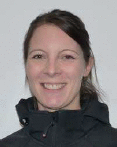
Eileen Y. ROBERTSON
Employment
Physiology, South Australian Sports Institute
Degree
PhD
Research interests
Altitude training, haemoglobin mass, functional overreaching, autonomic heart rate regulation
E-mail: eileen.robertson@sa.gov.au

Kevin G. THOMPSON
Employment
New South Wales Institute of Sport, Australia
Degree
PhD
Research interests
High performance sport; physiology of sport; pacing strategies and environmental challenges; management of high performance sports teams
E-mail: kevin.thompson@nswis.com.au
References
- Adams W.C., Bernauer E.M., Dill D.B., Bomar J.B. (1975) Effects of equivalent sea-level and altitude training on V̇O2 max and running performance. Journal of Applied Physiology 39, 262-266. [DOI] [PubMed] [Google Scholar]
- Bailey D.M., Davies B., Romer L., Castell L., Newsholme E., Gandy G. (1998) Implications of moderate altitude training for sea-level endurance in elite distance runners. European Journal of Applied Physiology 78, 360-368. [DOI] [PubMed] [Google Scholar]
- Baumann I., Bonov P., Daniels J., Lange G. (1994) Round table: high altitude training symposium. New Studies in Athletics 9, 23-35. [Google Scholar]
- Bonetti D.L., Hopkins W.G. (2009) Sea-level exercise performance following adaptation to hypoxia. Sports Medicine 39, 107-127. [DOI] [PubMed] [Google Scholar]
- Bonne T.C., Lundby C., Jørgensen S., Johansen L., Mrgan M., Bech S.R., Sander M., Papoti M., Nordsborg N.B. (2014) Live High–Train High” increases hemoglobin mass in Olympic swimmers. European Journal of Applied Physiology 114, 1439-1449. [DOI] [PubMed] [Google Scholar]
- Bosquet L., Montpetit J., Arvisais D., Mujika I. (2007) Effects of tapering on performance: a meta-analysis. Medicine and Science in Sports and Exercise 39, 1358-1365. [DOI] [PubMed] [Google Scholar]
- Chapman R.F., Stickford A.S.L., Lundby C., Levine B.D. (2014) Timing of return from altitude training for optimal sea-level performance. Journal of Applied Physiology 116, 837-843. [DOI] [PubMed] [Google Scholar]
- Chapman R.F., Stray-Gundersen J., Levine B.D. (1998) Individual variation in response to altitude training. Journal of Applied Physiology 85, 1448-1456. [DOI] [PubMed] [Google Scholar]
- Daniels J., Oldridge N. (1970) The effects of alternate exposure to altitude and sea-level on world-class middle-distance runners. Medicine and Science in Sports and Exercise 2, 107-112. [PubMed] [Google Scholar]
- Foster C. (1998) Monitoring training in athletes with reference to overtraining syndrome. Medicine and Science in Sports and Exercise 30, 1164-1168. [DOI] [PubMed] [Google Scholar]
- Fowler P.M., Knez W., Crowcroft S., Mendham A.E., Miller J., Sargent C., Halson S., Duffield R. (2017) Greater effect of east versus west travel on jet lag, sleep, and team sport performance. Medicine and Science in Sports and Exercise 49, 2548-2561. [DOI] [PubMed] [Google Scholar]
- Friedmann - Bette B. (2008) Classical altitude training. Scandinavian Journal of Medicine and Science in Sports 18, 11-20. [DOI] [PubMed] [Google Scholar]
- Garvican-Lewis L.A., Sharpe K., Gore C.J. (2016) Time for a new metric for hypoxic dose? Journal of Applied Physiology 121, 352-355. [DOI] [PubMed] [Google Scholar]
- Gastin P.B. (2001) Energy system interaction and relative contribution during maximal exercise. Sports Medicine 31, 725-741. [DOI] [PubMed] [Google Scholar]
- Gore C., Craig N., Hahn A., Rice A., Bourdon P., Lawrence S., Walsh C., Stanef T., Barnes P., Parisotto R., Martin D. (1998) Altitude training at 2690m does not increase total haemoglobin mass or sea-level V̇O2 max in world champion track cyclists. Journal of Science and Medicine in Sport 1, 156-170. [DOI] [PubMed] [Google Scholar]
- Gore C J., Hahn A.G., Burge C.M., Telford R.D. (1997) V̇O2 max and haemoglobin mass of trained athletes during high intensity training. International Journal of Sports Medicine 28, 477-482. [DOI] [PubMed] [Google Scholar]
- Gore C.J., Sharpe K., Garvican-Lewis L.A., Saunders P.U., Humberstone C.E., Robertson E.Y., Wachsmuth N.B., Clark S.A., McLean B.D., Friedmann-Bette B., Neya M. (2013) Altitude training and haemoglobin mass from the optimised carbon monoxide rebreathing method determined by a meta-analysis. British Journal of Sports Medicine 47, 31-39. [DOI] [PMC free article] [PubMed] [Google Scholar]
- Gough C.E., Saunders P.U., Fowlie J., Savage B., Pyne D.B., Anson J.M., Wachsmuth N., Prommer N., Gore C.J. (2012) Influence of altitude training modality on performance and total haemoglobin mass in elite swimmers. European Journal of Applied Physiology 112, 3275-3285. [DOI] [PubMed] [Google Scholar]
- Jensen K., Nielsen T.S., Fiskestrand A., Lund J.O., Christensen N.J., Sechef N H. (1993. High - altitude training does not increase maximal oxygen uptake or work capacity at sea-level in rowers. Scandinavian Journal of Medicine and Science in Sports 3, 256-62. [Google Scholar]
- Lange G. (1986) Load dosage and control during the acclimatisation phase of the altitude training of long distance runners: a report from experience. New Studies in Athletics 3, 29-46. [Google Scholar]
- Le Meur Y., Louis J., Aubry A., Guéneron J., Pichon A., Schaal K., Corcuff J.B., Hatem S.N., Isnard R., Hausswirth C. (2014) Maximal exercise limitation in functionally overreached triathletes: role of cardiac adrenergic stimulation. Journal of Applied Physiology 117, 214-222. [DOI] [PubMed] [Google Scholar]
- Levine B.D., Stray-Gundersen J. (1997) “Living high-training low”: effect of moderate-altitude acclimatization with low-altitude training on performance. Journal of Applied Physiology 83, 102-112. [DOI] [PubMed] [Google Scholar]
- Levine B.D., Stray-Gundersen J. (2006) Dose-response of altitude training: how much altitude is enough? Advances in Experimental Medicine and Biology 588, 233-247. [DOI] [PubMed] [Google Scholar]
- Lundby C., Millet G.P., Calbet J.A., Bärtsch P., Subudhi A.W. (2012) Does ‘altitude training’ increase exercise performance in elite athletes? British Journal of Sports Medicine 46, 792-795. [DOI] [PubMed] [Google Scholar]
- Mazzeo R.S. (2008) Physiological responses to exercise at altitude. Sports Medicine 38, 1-8. [DOI] [PubMed] [Google Scholar]
- Millet G.P., Roels B., Schmitt L., Woorons X., Richalet J.P. (2010) Combining hypoxic methods for peak performance. Sports Medicine 40, 1-25. [DOI] [PubMed] [Google Scholar]
- Millet G.P., Chapman R.F., Girard O., Brocherie F. (2017) Is live high–train low altitude training relevant for elite athletes? Flawed analysis from inaccurate data. British Journal of Sports Medicine pii: bjsports-2017-098083 [Epub ahead of print]. [DOI] [PubMed] [Google Scholar]
- Mujika I. (2013) The alphabet of sport science research starts with Q. International Journal of Sports Physiology and Performance 8 465-466. [DOI] [PubMed] [Google Scholar]
- Prommer N., Thoma S., Quecke L., Gutekunst T., Völzke C., Wachsmuth N., Niess A.M., Schmidt W. (2010) Total hemoglobin mass and blood volume of elite Kenyan runners. Medicine and Science in Sports and Exercise 42, 791-797. [DOI] [PubMed] [Google Scholar]
- Pugliese L., Serpiello F.R., Millet G.P., La Torre A. (2014) Training diaries during altitude training camp in two Olympic champions: an observational case study. Journal of Sports Science and Medicine 13, 666-672. [PMC free article] [PubMed] [Google Scholar]
- Rodríguez F.A., Iglesias X., Feriche B., Calderón-Soto C., Chaverri D., Wachsmuth N.B., Schmidt W., Levine B.D. (2015) Altitude Training in Elite Swimmers for Sea-level Performance (Altitude Project). Medicine and Science in Sports and Exercise 47, 1965-1978. [DOI] [PubMed] [Google Scholar]
- Saunders P.U., Telford R.D., Pyne D.B., Cunningham R.B., Gore C.J., Hahn A.G., Hawley J.A. (2004) Improved running economy in elite runners after 20 days of simulated moderate-altitude exposure. Journal of Applied Physiology 96, 931-937. [DOI] [PubMed] [Google Scholar]
- Saunders P.U., Pyne D.B., Gore C.J. (2009) Endurance training at altitude. High Altitude Medicine and Biology. 10, 135-148. [DOI] [PubMed] [Google Scholar]
- Schmidt W., Prommer N. (2005) The optimised CO-rebreathing method: a new tool to determine total haemoglobin mass routinely. European Journal of Applied Physiology 95, 486-495. [DOI] [PubMed] [Google Scholar]
- Sharma A.P., Saunders P.U., Garvican-Lewis L.A., Clark B., Stanley J., Robertson E.Y., Thompson K.G. (2017) Training at 2100 m altitude affects running speed and session RPE at different intensities in elite middle-distance runners. Int J Sports Physiol Perform 12, S2-147-152. [DOI] [PubMed] [Google Scholar]
- Solli G.S., Tønnessen E., Sandbakk Ø. (2017) The Training Characteristics of the World’s Most Successful Female Cross-Country Skier. Frontiers Physiology 8, 1069. [DOI] [PMC free article] [PubMed] [Google Scholar]
- Song A., Zhang Y., Han L., Yegutkin G.G., Liu H., Sun K., D’Alessandro A., Li J., Karmouty-Quintana H., Iriyama T., Weng T. (2017) Erythrocytes retain hypoxic adenosine response for faster acclimatization upon re-ascent. Nature Communications 8, 14108. [DOI] [PMC free article] [PubMed] [Google Scholar]
- Spilsbury K.L., Fudge B.W., Ingham S.A., Faulkner S.H., Nimmo M.A. (2015) Tapering strategies in elite British endurance runners. European Journal of Sport Science. 15, 367-373. [DOI] [PubMed] [Google Scholar]
- Stray-Gundersen J., Alexander C., Hochstein A., Levine B.D. (1992) Failure of red cell volume to increase to altitude exposure in iron deficient runners. Medicine and Science in Sports and Exercise 24, S90. [Google Scholar]
- Subudhi A.W., Bourdillon N., Bucher J., Davis C., Elliott J.E., Eutermoster M., Evero O., Fan J.L., Jameson-Van Houten S., Julian C.G., Kark J. (2014) AltitudeOmics: the integrative physiology of human acclimatization to hypobaric hypoxia and its retention upon reascent. PloS one 9, e92191. [DOI] [PMC free article] [PubMed] [Google Scholar]
- Townsend N.E., Gore C.J., Ebert T.R., Martin D.T., Hahn A.G., Chow C.M. (2016) Ventilatory acclimatisation is beneficial for high-intensity exercise at altitude in elite cyclists. European Journal of Sport Science 16, 895-902. [DOI] [PubMed] [Google Scholar]
- Wilber R.L. (2004) Altitude training and athletic performance. Champaign: Human Kinetics. [Google Scholar]


